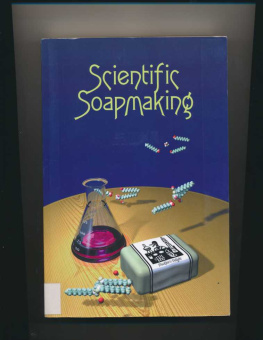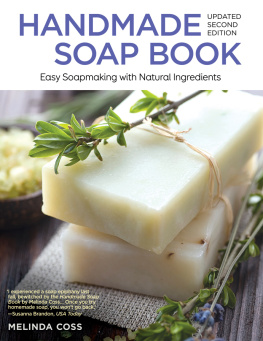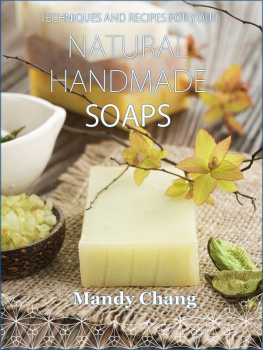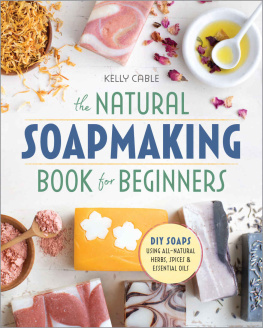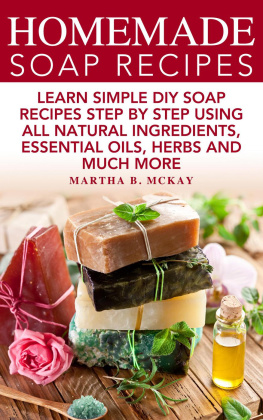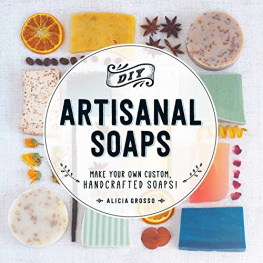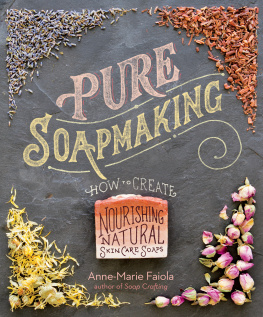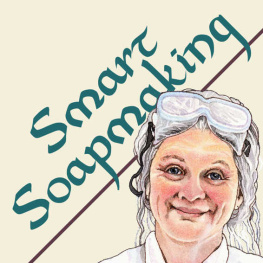Also by Kevin M. Dunn * Caveman Chemistry
List of Tables
Meanwhile, I continued to make soap, experimenting on my own with oil blends, temperatures, and mixing techniques. Looking for more reliable information, I found and purchased numerous old books on commercial soapmaking (1930 and before). There I found the chemistry I was looking forbut it was very advanced and, not having a firm science and chemistry background, I spent many hours looking up words and studying the materials. My soaps were good, and my understanding of the science was increasing, but I still felt like I was reinventing the wheel. The real chemistry and research for handcrafted soapmaking should be out there somewhere, shouldnt it?
Then, at the 2005 Annual Conference of the Handcrafted Soapmakers Guild, I attended Kevin Dunns presentation on the Dreaded Orange Spot. It was my ah-ha moment. Here was some actually researched and documented scientific data! In the subsequent years Kevin has presented his research into a number of different aspects of soapmaking, each time bringing proven data and filling in a piece of the scientific puzzle.
With the publication of Scientific Soapmaking, we who make handcrafted soap will finally have the true science and chemistry we need, presented in a way that is understandable even to those of us who didnt pay attention during science and chemistry classes.
Marie Gale
Past President, Handcrafted Soapmakers Guild Author, Soap & Cosmetic Labeling February 21,2010
Introduction
g hemistry is not widely viewed with admiration by the gen- eral public. Astronomy has the stars, twinkling suns
of unimaginably distant planets from which, perhaps, alien stargazers peer into the night sky and ponder our existence as we ponder theirs. Biology has ornate birds and fragrant flowers and glow-in-the-dark creatures of the ocean depths. Paleontology has myriad monsters both large and small, emerging, thriving, and vanishing over eons that dwarf our conceptions of eternity. Archeology has mummies, skeletons, lost tombs, splendid treasures of ancient civilizations, and the romance of dust left undisturbed by the passage of time. These are the sciences that inspire fiction. By contrast, there is no quicker end to a cocktail-party conversation than to confess a passing acquaintance with the Periodic Table. It is no wonder, then, that students shun chemistry in favor of her more personable sisters.
Yet the past thirty years have seen a renaissance in a long-forgotten chemical craft. This resurgence of interest was led, not by educators or industrial chemists or government agencies, but by modern-day alchemists working in kitchen laboratories that hearken back to the very dawn of the science. Retorts and furnaces have been replaced by Pyrex measuring cups and microwave ovens, base metals by lard and tallow and olive oil. Their Philosophers Stone lyes hidden on grocery-store shelves, accessible only to those who appreciate its terrible power. And their gold, like that of their hermetic forbears, is considered the key to health and longevity.
Soapmaking is now a well-established cottage industry, successfully competing with multi-national giants whose products sell for a fraction of the price of handcrafted soap. The Internet hums with websites and forums and mailing lists devoted to teaching and outfitting hobbyists and entrepreneurs alike. There are many wonderful books, most of them by women without formal training in chemistry, that provide a veritable cor-
lucopia of recipes for soaps of every description. What need is here for another book, particularly one penned by a man and cWemist? While my sex and profession are under-represented mong practitioners of the craft, I am no less smitten by the oap bug, and it is with a sense of profound humility that I ven-ure to add a few words to the soapmaking literature.
Within the soapmaking literature there are really two dis-inct genres. The older of the two serves the traditional com-nodity industry with an emphasis on the economical produc-ion of soap by the ton, and its readership is expected to have a )ackground in chemistry and chemical engineering. The new->r genre serves the emerging craft industry with an emphasis m the production of high-quality soaps by the pound, and its eadership is familiar with the language and format of cook-jooks. Though the processes used by the two industries are re-illy quite different, many of the principles are the same. By selectively borrowing scientific techniques from the commodity literature, I believe that makers of handcrafted soap would be better able to resolve problems and improve the quality of the products they so love. If I can bridge the gap between the commodity and craft literatures, I will consider my time to have been well spent.
There is nothing wrong with making soap from a recipe. There is nothing wrong with testing your soap by simply washing your hands with it and deciding whether or not you like it better than your last batch. But for many soapmakers, the thrill of early success eventually succumbs to the frustration of the scent that faded, the bar that never quite hardened, and the dreaded orange spots that disfigured an otherwise perfect bar of heaven-on-earth. The scientific approach to handcrafted soapmaking differs from the cookbook approach simply in the following proposition: We can explore the complexities of soap by changing one variable at a time and objectively evaluating the results.
The systematic approach need not drain soapmaking of joy or adventure. It simply adds method to the madness of spending hours in loving labor to make a product that must compete with those available ready-made at any grocery store. You may continue to use your favorite recipes, employing the methods of this book to solve problems as they arise. You may from time to time throw caution to the wind, blending whatever oils you happen to have on hand just to see what will come of it. You may simply be interested in how one chemist faces the challenges imposed by nature on this fundamentally chemical craft. The systematic approach has deepened my appreciation for this nearly magical avocation and has provided structure to my own personal exploration of its wonders. Whether you be a rank amateur or an established entrepreneur, I hope that you will find something of value in these pages. And, perhaps along the way, you will find in chemistry a beauty largely unappreciated by the general public.
To the Handcrafted Soapmaker
Many of the makers of handcrafted soap I have met confess that they wish they had paid more attention to high school chemistry. The arcane formulas and exotic glassware, the indecipherable names and brown glass bottles of stink seemed boring, dangerous, or irrelevant at the time. But these folks now find themselves determined to learn concepts they vaguely remember resisting in their youth. If you are such a person, I have written this book for you. In my mind, it is the textbook for the chemistry course you now wish you had taken in high school or college. I hope you enjoy it.
Next page
